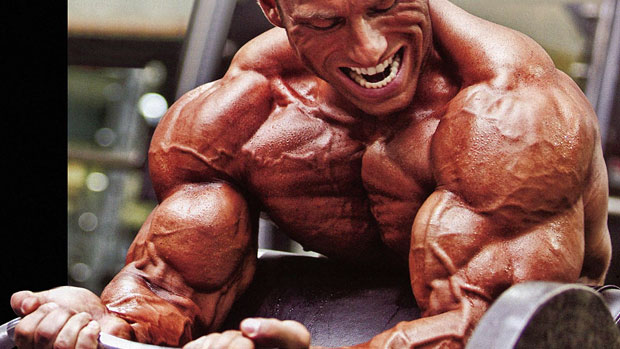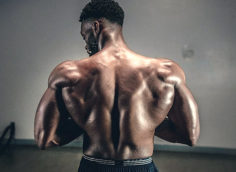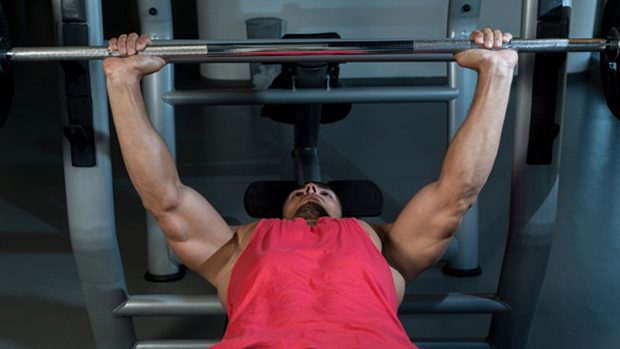Walk into any decent gym and you'll have multiple choices for whatever movement pattern or muscle group you want to train that day. Should you do pulldowns or pull-ups? Bench presses with a barbell or on the Smith machine? Squats or leg presses?
If you think the answers are obvious, I beg to differ.
Exercise selection, clearly, is not the only important variable in a training program. You have to make intelligent decisions about volume, intensity, and frequency as well – how much, how hard, and how often you train. And, just as clearly, you can't make good choices in those areas unless you define your goals.
You can find lots of articles – entire books, even – that tell you how to adjust volume, intensity, and frequency when you're training for strength vs. hypertrophy. But what you rarely find is any guide to selecting the right exercises for those two goals. That, in my view, is a pretty big gap. Not all exercises are created equal, and some are better at yielding specific results than others.
For this article, I'm going to break down exercise selection into two primary categories: the best exercises for strength, and the best for hypertrophy. If you're interested in achieving both at the same time, you can just select the exercises that appear on both lists.
Certainly, there are other categories that I'm leaving out – the best exercises for fat loss, athletic development, mobility, muscular endurance ... the list could go on a while. But the two I listed are the big ones, the ones most of you are currently pursuing.
Industrial Strength
I think everyone reading this understands that the size of a muscle affects its strength, up to a point. But we all know that bodybuilders – the biggest guys in the gym in terms of pure muscular size – aren't by any stretch the strongest. They're stronger than the skinny dudes on the Bosu balls, of course, but most of them would get smoked by the top powerlifters in their weight class.
That's because maximal strength – the muscles' ability to perform a single, all-out effort – depends on neuromuscular coordination as well as the amount of contractile tissue within the muscle.
So, when selecting an exercise for the goal of developing maximal strength, you need to choose one that allows you to lift the most weight and requires the most skill.
Both halves of that statement are important.
You already know you won't get strong unless you choose exercises that allow you to lift a lot of weight. You can't get strong with light weights, even if you're lifting from an awkward or unstable position.
So when I say the exercises you choose must require skill, I'm talking about lifts that require some technique and balance, not the ones that look like circus tricks. High-skill exercises are usually compound – involving action at more than one joint – and take place in multiple planes of movement, or at least have the possibility to do so.
Neuromuscular coordination is crucial because of the concept of the transfer of skill, or how your ability in one exercise crosses over to another. The key to understanding this concept is to remember that the transfer of skill flows downhill. Your ability to perform a higher-skill exercise, like a bench press, means you'll also be pretty good at a lower-skill version of that same basic movement, like a machine chest press.
Skill rarely flows the opposite direction. If you only trained on a selectorized chest-press machine, you wouldn't be commensurately strong on the barbell bench press.
Think of arm wrestling, a sport that requires a combination of strength and skill. A guy can have fantastically strong arms, as demonstrated by his ability to lift heavy weights in lower-skill exercises, but if he's never arm-wrestled before, not only is he going to lose his match, there's a good chance he'll get hurt in the process. He has strong muscles pulling on bones, tendons, and ligaments in an unfamiliar way, and that's a perfect formula for injury. (Ironically, a weaker arm-wrestling novice has less chance of injury. He'll just lose the match, without lasting damage to anything but his ego.)
Speaking of skill, you may notice when you get to the exercise lists that I don't include the Olympic lifts in this discussion. They obviously require skill, and they obviously allow you to improve strength. But because they emphasize speed, power, and coordination over pure strength, I think they're part of a different discussion. They wouldn't be first-choice exercises for pure strength or pure hypertrophy, although they'd certainly be in the mix if we were talking about training to improve speed and power.
Supersize Me
Here's the guideline to remember when you're trying to build maximum muscle size:
Choose exercises that allow you to lift the most weight andoffer the most isolation on the target area.
The first part – lifting the heaviest weights – is more obvious for strength, but applies to hypertrophy training as well. You need to lift a lot of weight to force the muscle to grow to its maximal size. The 10-pound dumbbells aren't going to build much size no matter how you use them.
But it's with the second criterion that things get interesting. Neuromuscular coordination doesn't matter much for bodybuilding. You don't need to worry about skill transfer. Instead, you want to make sure that a specific muscle, or muscle group, is doing the work.
That doesn't mean you'll rely solely on isolation exercises, but it does mean you should feel the muscle working during the set, and feel a difference within the muscle afterwards. You want to get a pump, to feel the burning sensation in the muscle (which we used to think was caused by lactic acid), and/or feel post-workout soreness a day or two later.
Those are all signs of effective muscle isolation.
Conversely, when you're training for strength, you don't want to feel the muscles working, or to establish a mind-muscle connection; you just want to do the movement.
One more important point: If you're a relatively new or inexperienced lifter, you need to establish a base level of strength before you worry about muscle isolation. It doesn't matter if your only goal is to get huge. You can't achieve that without the base. How do you know when you're ready? You should at least be at the "decent" level of strength in most of the exercises I described in Are You Strong.
If you aren't at least decent in the powerlifts – capable of using 1.5 times your body weight in the squat and deadlift and 1.25 times your weight in the bench press – you're going to struggle to add muscle mass with isolation exercises. Your body won't be able to handle heavy enough weights to make those exercises effective.
Starting at the "good" level is even better, but I know it's unrealistic to tell a guy who just wants bigger muscles that he should wait until he can squat or deadlift twice his body weight before he starts doing exercises specific to his main goal.
When you look at the list of exercises in this category, you're going to see several, like Smith machine squats, that many coaches at Testosterone Muscle would tell you not to do. Understand that I'm recommending these exercises for their specific purpose – to build size or strength. As a powerlifter, I don't do some of them, and as a coach I might not have my athletes do them. I'm just pointing out that they fit the two criteria I mentioned at the start of this section: They allow you to lift heavy weights while isolating the muscles you're targeting.
Exercises like that aren't likely to make you a better athlete. They probably won't help your vertical jump very much, and if you don't also do a lot of traditional squatting they won't bump up your 1RM much. They can be effective for building size, and little else. If that's what you want, they might be good choices for you.
I also think they can be done with good form and without excessive injury risk. I wouldn't include them if I thought they were dangerous.

The squat makes you stronger, bigger, and most important of all, veinier.
Bigger and Stronger
So what do you do if you're training for both size and strength? Or if you haven't yet achieved "decent" strength in the major exercises, and need to get strong before you can get big? Simple: Just look for exercises that appear in both lists, and build your programs around them.
Those are also the best exercise choices for those who play competitive sports and want a head-turning physique. Because they require some skill, they offer more transfer to sports performance, and perhaps lower your risk of injury outside the gym.
About the following lists:
By necessity, I arranged the exercises by muscle group. Not everyone categorizes exercises that way, but I had to use designations that would work for both goals. Because of this arrangement, many exercises could fit into multiple categories. For example, a barbell bench press is more than a "chest" exercise; it also builds the front of your deltoids and your triceps. (In fact, some of the best exercises for biceps and triceps might very well be exercises in the "back" and "chest" categories – chin-ups for biceps, close-grip bench presses and dips for triceps.)
For each muscle group, I offer a "testing" exercise. I recommend you work to develop at least decent strength in that exercise before you focus exclusively on hypertrophy, if that's your goal.
Muscle Group
Chest
- Testing exercise:
- Barbell bench press
- Decent strength:
- 225 pounds, or 1.25 times body weight
- Best exercises for strength:
- Barbell bench press (flat, incline, decline, close-grip, board press with 1-3 boards)
- Dumbbell bench press (flat, incline, decline)
- Floor press
- Rack press
- Dip (preferably using extra weight and/or on gymnastics rings)
- Push-up (weighted and/or on rings)
- Best exercises for size:
- Barbell bench press (flat and incline)
- Dumbbell bench press (flat and incline)
- Smith-machine bench press (flat and incline)
- Hammer Strength chest press (flat and incline)
- Selectorized chest-press machines (flat and incline)
- Power dumbbell fly, aka bent-arm fly (flat and incline)
Lats
- Testing exercises:
- Pull-up or barbell bent-over row (torso at 45-degree angle to floor)
- Decent strength:
- 10 pull-ups with body weight; 225 pounds or 1.25 times body weight on bent-over row
- Best exercises for strength:
- Pull-up and chin-up (add extra weight when you can do 10 with your body weight)
- Barbell or dumbbell bent-over row (torso at 45- or 90-degree angle to floor)
- Dumbbell row
- Hammer Strength plate-loaded back machines (but not the chest-supported-row)
- Cable row
- Lat pulldown (if you can't yet do sets of pull-ups and chin-ups with your body weight)
- T-bar row
- Best exercises for size:
- Pull-up and chin-up
- Barbell or dumbbell bent-over row (torso at 45- or 90-degree angle to floor)
- Dumbbell row
- Hammer Strength plate-loaded back machines
- Cable row
- Lat pulldown
- Standing straight-arm lat pulldown
- Machine pullover
Shoulders (deltoids and upper traps)
- Testing exercise:
- Standing barbell military press
- Decent strength:
- 105 pounds, or 60 percent of body weight
- Best exercises for strength:
- Military press (barbell or dumbbells; standing or seated)
- Push press (barbell or dumbbells)
- Barbell rack military press
- Arnold press
- Handstand push-up
- Best exercises for size:
- Seated military press (barbell or dumbbells)
- Smith-machine military press
- Hammer Strength shoulder press
- Arnold press
- Selectorized shoulder-press machines
- Lateral raise (dumbbell, cable, or machine; standing or seated; leaning or upright; Power/bent-arm or regular)
- Power/bent-arm dumbbell rear-delt raise
- Rear-delt machine
Biceps
- Testing exercise:
- Strict EZ-bar curl
- Decent strength:
- 80 pounds, or 40-50 percent of body weight
- Best exercises for strength:
- EZ-bar curl (strict, normal, or cheat)
- Parallel-bar curl
- EZ-bar reverse curl
- Dumbbell hammer curl
- Dumbbell alternating curl
- Best exercises for size:
- EZ-bar curl (strict, normal, or cheat)
- Parallel-bar curl
- EZ-bar reverse curl
- Dumbbell hammer curl
- Dumbbell alternating curl
- Cable curl (all varieties)
Triceps
- Testing exercise:
- EZ-bar skull crusher
- Decent strength:
- 70 pounds, or 35-45 percent of body weight
- Best exercises for strength:
- Skull crusher (EZ bar, cable, or dumbbells)
- Overhead triceps extension (EZ bar, 1 or 2 dumbbells)
- High-rack press
- High-board press
- Dip (body more vertical)
- Best exercises for size:
- Skull crusher (EZ bar and dumbbells)
- Overhead triceps extension (EZ bar, 1 or 2 dumbbells)
- Triceps pushdown
- Cable skull crusher
- Pullover (EZ bar, 1 or 2 dumbbells)
Legs (emphasis on quads)
- Testing exercise:
- Squat or leg press
- Decent strength:
- 315 pounds or 1.5 times body weight for squat; 410 pounds or 2-2.25 times body weight for leg press
- Best exercises for strength:
- Squat (high or low bar)
- Front squat
- Box squat
- Rack squat
- Best exercises for size:
- Squat (high or low bar)
- Front squat
- Leg press
- Smith machine squat
- Smith machine front squat
- Lunge (barbell or dumbbells)
- Leg extension (quads only)
Legs (emphasis on hamstrings, glutes, spinal erectors)
- Testing exercise:
- Deadlift
- Decent strength:
- 315 pounds, or 1.5 times body weight
- Best exercises for strength:
- Deadlift (conventional, sumo, Romanian, stiff-legged)
- Glute-ham raise
- Good morning
- Reverse hyperextension
- Best exercises for size:
- Deadlift (conventional, Romanian, stiff-legged)
- Glute-ham raise
- Good morning
- Reverse hyperextension
- Back extension (weighted)
- Leg curl (lying, standing, seated)
Abs
- Testing exercise:
- Weighted decline sit-up (weight held on upper chest)
- Decent strength:
- 40 pounds, or 20-25 percent of body weight
- Best exercises for strength:
- Weighted decline sit-up
- Hanging knee or leg raise
- Cable crunch (standing or kneeling)
- Ab-wheel rollout
- Best exercises for size:
- Weighted decline sit-up
- Hanging knee or leg raise
- Cable crunch (kneeling)
- Machine crunch
- Roman chain knee or leg raise
- Weighted Swiss-ball crunch
Final Thoughts
I had to leave out as many exercises as I put in when I made these lists. Lots of perfectly good exercises for smaller muscles like calves and rear delts don't make the list, simply because there's someone training exclusively for strength probably wouldn't train those muscles in isolation for that goal.
Similarly, exercises used for prehab or rehab, or to develop mobility, endurance, or stability, got left out. They're great exercises for lifters with a variety of goals, but they don't lend themselves to the strength-vs.-size comparison.
If you take anything away from this article, I'd like you to remember the two most important points:
- When training for strength, choose exercises that allow you to lift the most weight and require the most skill.
- When training for size, choose exercises that allow you to lift the most weight and offer the most isolation on the target area.
The other big point, which I hope you'll remember and incorporate, is that you shouldn't focus exclusively on size until you've achieved at least "decent" strength in the major exercises.
Finally, I'll offer the standard reminder that none of these exercises will work for any goal if you don't manage the other elements of your training program – volume, intensity, frequency – as well as what you do outside the gym. Without proper food and supplements, good sleep habits, and sensible recovery between workouts, it doesn't matter which exercises you choose.
That said, if you get everything else right, or mostly right, then matching your exercise selection to your goals could be the final piece of the puzzle.





